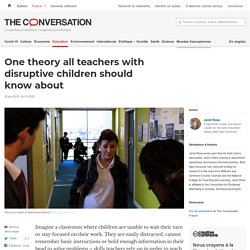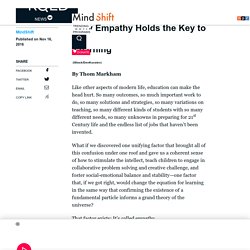

If Gentle Discipline Isn't Working, This Might Be the Reason - Janet Lansbury. If you’re reading here because you’re committed to guiding your child’s behavior without spankings or punishments, I salute you, especially if you were punished as a child and are looking for a better way.

Setting limits without punishments works. In fact, it works so beautifully that you’ll find you need to set fewer and fewer limits, especially once the toddler years have passed. Many of you have sent me inspiring stories about the positive results you are experiencing, often immediately. I also hear a lot about what isn’t working from parents who believe they are practicing gentle discipline. Parents share about behavior that might have started as minor testing but has become more aggressive, destructive, defiant or deliberate. Parents wonder: How can my child keep acting this way when I’m committed to respectful, non-punitive guidance?
This ‘Kindness Curriculum’ Is Free And Should Be Used In Every Classroom. Imagine living in a world that valued kindness enough to teach it along with academics. Educators would teach kids to manage their emotions in addition to standard curriculum such as math and science. Sounds pretty amazing, doesn’t it? Well, the Center for Healthy Minds at the University of Wisconsin-Madison has created a free “kindness curriculum” for kids, designed to do just that. 21 of the Best Early Years Books for International Friendship Day. We know that skills like empathy aren’t fully developed until later in a child’s life, which is why there are so many stories on friendship and how to treat people aimed at Early Years. International Friendship Day, then, is a great opportunity to share some of these amazing books with your children.
It does, however, fall on Sunday 30 July. So celebrating on the day itself is going to be difficult, doubly so for Reception classes who are on summer holidays. Here are our picks for some top tales that touch on various aspects of friendship that kids will love. 1 | Bubble Trouble Tom Percival (Bloomsbury, paperback, £6.99) Reuben and Felix are best friends, whose favourite thing in the world to do is to blow bubbles. Review: Bubble Trouble. 2 | Little Puppy Lost Holly Webb (Little Tiger Press, paperback, £6.99) Review: Little Puppy Lost. The Key to Effective Classroom Management.
It’s a daunting but all-too-common sight for many teachers: A classroom full of rowdy students who are unable to focus on the lesson. Classroom management techniques may get things back on track, but valuable time has already been lost. Many experienced teachers know that making meaningful connections with students is one of the most effective ways to prevent disruptions in the first place, and a new study set out to assess this approach. A 19-Year Study Reveals Kindergarten Students With These 2 Skills Are Twice as Likely to Obtain a College Degree (and They Have Nothing to Do With Reading) One theory all teachers with disruptive children should know about. Imagine a classroom where children are unable to wait their turn or stay focused on their work.

They are easily distracted, cannot remember basic instructions or hold enough information in their head to solve problems – skills teachers rely on in order to teach successfully. These behavioural issues are all examples of problems that can arise from attachment issues – based on the relationship between children and their main caregiver. Attachment theory is now one of the world’s most well-researched theories about human development.
It was first proposed by the 20th-century British psychiatrist John Bowlby, who considered that children needed to develop a secure attachment with their main caregiver via sufficiently consistent, responsive, sensitive, appropriate and predictable care and support. Research has shown that secure attachments create mental processes that enable a child to regulate emotions and attune to others. Don't Expect Toddlers To Behave Consistently — They Literally Can't. One day, when my oldest daughter was not quite 2, she wouldn’t sit still to let me change her diaper. Squirrelly and writhing, she made a game out of staying half naked. She wasn’t fussing about it or anything — in fact, she was giggling maniacally.
The problem was that we were running late. Nothing I did seemed to faze her. I tried distracting her with a toy. Can Free Play Prevent Depression and Anxiety In Kids? KQED Public Media for Northern CA. Babies and toddlers raised in supportive and caring home environments tended to do better on standardized tests later on, and they were more likely to attain higher degrees as adults.

They were also more likely to get along with their peers and feel satisfied in their romantic relationships. "It seems like, at least in these early years, the parents' role is to communicate with the child and let them know, 'I'm here for you when you're upset, when you need me. And when you don't need me, I'm your cheerleader,' " says Lee Raby, a psychologist and postdoctoral researcher at the University of Delaware who led the study. Raby used data collected from 243 people who participated in the Minnesota Longitudinal Study of Risk. All the participants were followed from birth until they turned 32. KQED Public Media for Northern CA. To make that argument requires a deep dive into the profound nature of empathy.

Right now, empathy roughly equates to “I like you and am willing to tolerate you regardless of differences because I am a good person.” But the textbook definition hints at something more profound: It’s ‘the feeling of being able to understand and share another person’s experiences and emotions.’ Positive Learning Environment - Primary. Background to the Concept of Schema. EducatorsEn. Relationships with children. Further reading. Key Person & Attachment - Early Years Matters.
The Key Person Children thrive from a base of loving and secure relationships. This is normally provided by a child’s parents but it can also be provided by a key person. A key person is a named member of staff with responsibilities for a small group of children who helps those children in the group feel safe and cared for. How Are Happiness and Learning Connected? As teachers, we also know that when students' affective filters or defenses are sky high, fight or flight responses will be modus operandi. A room full of defensive behaviors (withdrawn, angry) is a sad, unproductive place to teach and learn.
Now let's flip it and take a look at how much more we are able to learn when we are in harmony with the people and things in any given educational environment. Being in harmony means feeling safe, feeling valued and a necessary part a group, and in this case, a learning community. Hearts and Minds in Sync What does research show to be the opposite of the brain's fight or flight response? ONE or TWO. how you think they contribute to an enabling environment?
Serve and Return. Surprisingly Simple Techniques for Challenging Behaviour. I often get asked about children’s behaviour. It is a massive topic, with many facets. However, I would always start from the perspective that all behaviour, good or unacceptable, is a form of communication. It is how we, as practitioners and adults, respond to that communication that makes all the difference. The Webster Stratton method is a well known and widely used behaviour management strategy.